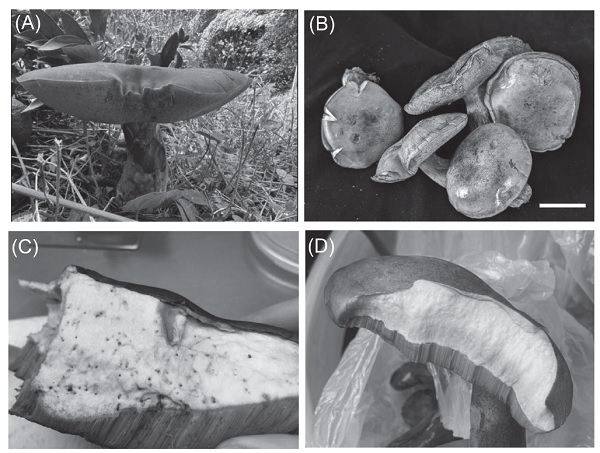All issues

Author:Shiang-Shiuan Yu, Cheng-Yu Tsai, and Yun-Sheng Lu*
Abstract:
Mushrooms are rich in nutrients and popular delicacy. However, due to limitations in cultivation techniques, some mushrooms that are symbiotic with plants still rely on wild harvesting. Boletes are well-known edible wild mushrooms. In 2024, samples similar to bolete mushrooms were collected in Taichung and Yunlin, Taiwan. Both fruiting bodies were medium to large in size with a dark brown pileus surface and the porous structure of hymenium. Upon vertical sectioning of the pileus, the context was yellow sponge-like tissue. Two isolates, designated Ph-1 and Ph-2, were isolated from these samples. To further identify the two isolates, the internal transcribed spacer (ITS) region of rDNA was amplified by polymerase chain reaction (PCR) with the primers ITS1/ITS4 and sequenced. Phylogenetic analysis preliminarily identified both isolates as Phlebopus sp. Additionally, to investigate the optimal cultivation conditions of isolates, their colony lengths were measured on three different media including potato dextrose agar (PDA), potato rice bran (PR), and sawdust potato glucose (SPG) medium. The results showed that Ph-1 grew faster than Ph-2 on all three media, and both isolates exhibited the highest growth rate on the SPG medium. It indicated that sawdust effectively promotes the mycelial growth of Phlebopus sp. Bolete mushrooms are well-known for their unique flavor and fleshy texture. This study is the first report to identify the Phlebopus sp. isolated from Taiwan by combining phenotype and ITS sequence analysis. To establish commercial cultivation methods for bolete mushrooms in Taiwan, future research will focus on cultivating fruiting bodies and evaluating the feasibility of artificial cultivation.
Key words:Edible bolete, Phlebopus sp., Mycelium growth medium
Download:![]() PDF Links
PDF Links
 Submit your manuscript
Submit your manuscript
 Guide for authors
Guide for authors